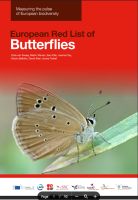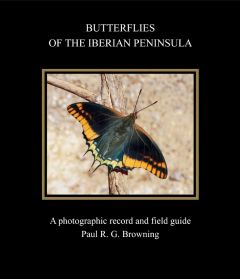| Home | About EBG | Countries | Events | Holidays | News | Requests | Species | Contacts & Links | |
|
 To
conserve butterflies effectively we need to have good information on
species
distributions and trends in abundance. However outside parts of western
and northwestern
Europe such data is sparse. To
conserve butterflies effectively we need to have good information on
species
distributions and trends in abundance. However outside parts of western
and northwestern
Europe such data is sparse.Sam Ellis, Chair Butterfly Conservation Europe, has written a comprehensive review on how to make the most of your butterfly recording and monitoring data in Europe: European Butterfly Recording and Monitoring (PDF) Several European countries have both national and regional butterfly recording schemes. Please refer to the 'Countries' page, or contact the EBG representative for information on these schemes and for where to send records for Bulgaria, Cyprus, France, Germany, Greece, Hungary, Italy, Portugal, Spain and Sweden. You can download an Excel European Butterfly Distribution list here. By running the macro in the Excel file you can see the species list for the country of your choice. The following
guides provide help with the identification of European butterfly
species and are free to download.
We
offer a Butterfly Identification Service whereby you can send us your
photographs of butterflies for identification.
(NB: for a European Butterfly Species Distribution Checklist see Butterfly Recording - making the most of your data)
UPDATED CHECKLIST OF EUROPEAN BUTTERFLY SPECIES Download : EuropeanButterflies.xls The list of 454 species on the first spreadsheet comprises species found in Europe up to the eastern boundary of the European Union. It includes Cyprus, the Canary Islands, Madeira, and the Azores. A further 42 species which only occur east of the European Union (in Russia, etc) are listed separately on the second spreadsheet. The list follows the updated checklist of European Butterflies which was published on 31 December 2018 in the journal ZooKeys and can be accessed as follows: The updated checklist was compiled by an international committee of taxonomic experts which comprised Martin Wiemers (corresponding author), Emilio Balletto, Vlad Dinca, Zdenek Fric, Gerardo Lamas, Vladimir Lukhtanov, Miguel Munguira, Chris van Swaay, Roger Vila, Albert Vliegenthart, Niklas Wahlberg, and Rudi Verovnik. It is the same piece of work as the checklist published in the EIG Anniversary Magazine in May 2017 (which was an advanced draft of the committee’s conclusions) but with a few updates and corrections, the main ones being as follows. Main changes Polyommatus timfristos is added as a new species. This is an Anomalous Blue from the Timfristos and Parnassos mountains in central Greece. Polyommatus eleniae (Phalakron Anomalous Blue) is now considered conspecific with Polyommatus orphicus (Kolev’s Anomalous Blue). The split of Euphydryas beckeri (Iberian Marsh Fritillary) from Euphydryas aurinia (Marsh Fritillary) is dropped. Hypolimnas missipus (Danaid Eggfly) is added to the list. This tropical species has been recorded and is possibly breeding in the Canary Islands, and has been recorded in Madeira. Pieris wollastoni (Madeiran Large White) is now classified as extinct. The scientific name of the recently split Southern Heath Fritillary is corrected from Melitaea nevadensis to Melitaea celadussa. Argynnis aglaja (Dark Green Fritillary) is now Speyeria aglaja. Argynnis niobe (Niobe Fritillary), Argynnis elisa (Corsican Fritillary) and Argynnis adippe (High Brown Fritillary) become Fabriciana niobe, Fabriciana elisa and Fabriciana adippe. Nevada Grayling becomes Pseudochazara williamsi.  The 2025 European Red List of butterflies was released by the IUCN on 11th Oct 2025, you can download the Red List, read the key findings and species accounts from BCE's website here  Paul
Browning's book 'Butterflies of the Iberian Peninsula' was first
published in 2011. It filled a particular gap in the market and proved
to be a very useful guide. The limited print run sold out quickly and
now the book is out of print. Paul
Browning's book 'Butterflies of the Iberian Peninsula' was first
published in 2011. It filled a particular gap in the market and proved
to be a very useful guide. The limited print run sold out quickly and
now the book is out of print. The revised edition available here contains a lot of information which was not included in the original version. The text is comprehensive, accurate and contains a wealth of information on the butterflies of Spain and Portugal. Paul would like EBG members to have access to this information and has very kindly let us provide this revised version of the 'Butterflies of the Iberian Peninsula' as a free resource on the European Butterflies Group website. Please note the PDF file size of the book is 107mb and will take a while to download on slow broadband. Download : Butterflies of the Iberian Peninsula by Paul R. G. Browning  A photographic
guide. Butterflies of Central Europe and Britain by Peter Gergely A photographic
guide. Butterflies of Central Europe and Britain by Peter Gergely
 This useful field guide, produced by de Vlinderstichting (Dutch Butterfly Conservation) is available to download as a free resource in pdf, see here. The guide includes 269 species occurring in Britain, Western and Central Europe. |
| Top of Page |